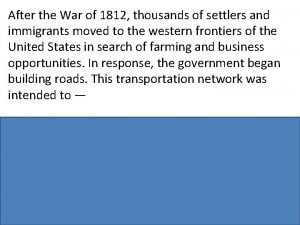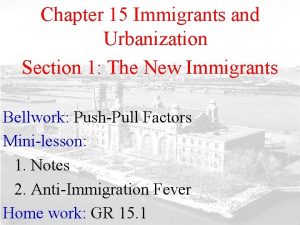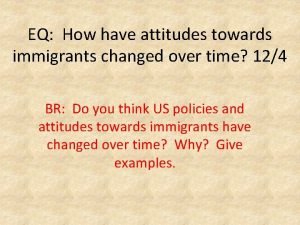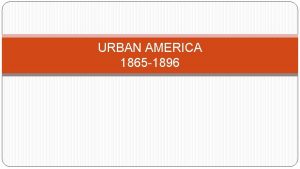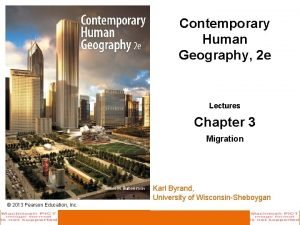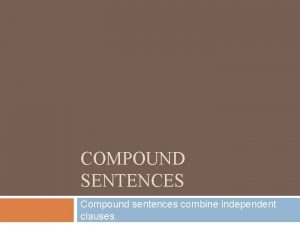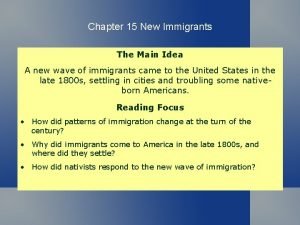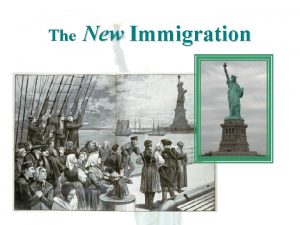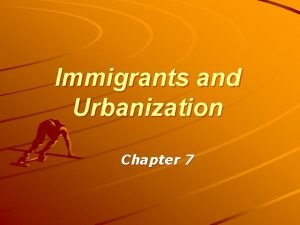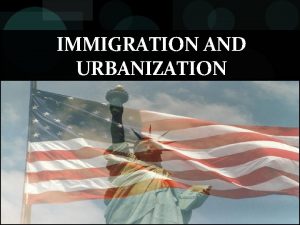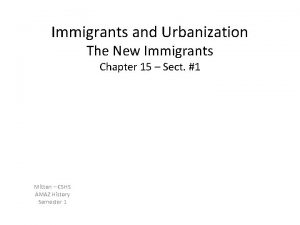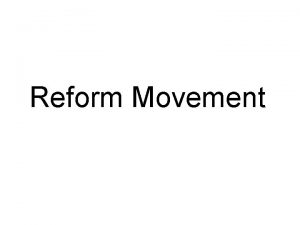Unit 6 Cities Immigrants and Farmers Cities What












- Slides: 12

Unit 6 Cities, Immigrants, and Farmers

Cities What is Urbanization? Reasons for Urbanization (pull factors) • Railroads made it easier to move to cities • Cities had more cultural opportunities and night life • Rise of factories created more jobs

Problems for New Cities Overcrowding Slums Lack of needed resources Poor sanitation Political Corruption Pollution Vast wealth differences Traffic congestion

Political Machines • Political machines controlled local politics by “encouraging” citizens to vote for their candidates, and by exchanging political favors and other rewards • The most famous political machine was Tammany Hall (NYC) led by William “Boss” Tweed • These political machines would make profits by overcharging on city contracts and “kickbacks” • Eventually, the public turned on the political machines led by Thomas Nast who attacked Tweed and Tammany Hall in his series of political cartoons

Immigrants Old Immigrants (before 1880) • Most came from Western Europe • Most came to America to escape religious persecution or to find new economic opportunities • Most spoke English New Immigrants (1880 -1924) • Most came from Southern and Eastern Europe • Most came to America to escape religious or political persecution • Most spoke little to no English • Most were processed through Ellis Island

Immigrant Challenges • Most immigrants took the first unskilled job they were offered in the Northeast or Midwestern U. S. • To help them assimilate into American society, immigrants often settled into ghettos – urban neighborhoods with the same nationality as their own • This allowed immigrants to “assimilate” into American society slowly while still maintaining their ethnic cultural heritage • The immigrant children would attend public schools, learn English, and “assimilated” quicker. This sometimes caused conflict between immigrant family generations.

Asian Immigration Chinese immigrants • Most arrived after the discovery of gold in California in 1848 • Some became laborers for the transcontinental railroad and could earn 10 times more money than in China • They were heavily discriminated against due to the way they looked, dressed and lack of English language • U. S. passed the Chinese Exclusion Act in 1882 which placed a ban on Chinese immigration for 10 years • After 1910, limited Chinese merchant immigration continued and they were processed at Angel Island in San Francisco

Asian Immigration (continued) Japanese immigration • First immigrants arrived in 1869 from Japan, providing a source of cheap labor, working on farms, mines, and railroads • In 1907 a “Gentlemen’s Agreement” was negotiated with Japanese leaders, which prevented further immigration into the U. S. except for the wives and children of the men already in the U. S. The Rise of Nativism (late 19 th century) Nativism – belief that native born Americans were superior to others • Americans viewed the new immigrants as dirty and unhealthy, fearing they would lower American standard of living • Led to the rise of anti-immigration societies (KKK, Immigration Restriction League)

Problems for Farmers • Agricultural overproduction – grew more crops than needed, so prices fell…. good for the consumer, terrible for the farmer • International competition – improved transportation allowed foreign countries to ship crops to America quickly and cheaply • Middlemen – farmers sold their crops to “middlemen” when the prices were low, then the “middlemen” would sell the crops to the main cities when the prices were high • High shipping costs – railroads charged more money to ship shorter distances than longer distances • Farm debt – deflation made farmer’s loan payments hard to pay as food prices continued to drop • Natural disasters – farmers were at the mercy of mother nature, including crop diseases, insects, and droughts

Grange Movement • Oliver Hudson Kelley organized the “Grange Movement” in 1867 • This farmer association tried to break the rural isolation and spread new farming techniques • Within 10 years, there were 1. 5 million members • Tried to replace the “middlemen” with cooperatives • Farmers turned to politics, electing many state legislators that passed farmer friendly laws regulating railroad rates and grain storage rates • Munn v. Illinois (1877) the U. S. Supreme Court ruled that a state government could regulate a private utility if it was serving the public interest • Wabash v. Illinois (1886) the U. S. Supreme Court ruled that state governments could not regulate railroads running through more than one state, invalidating many “Granger Laws”

Interstate Commerce Act (1887) • Congress passed this legislation to regulate unfair business practices, like having different railroad rates for shipping the same distances, or charging more for shorter distances Populist Party • Formed by members of the local “Farmers Alliances” to represent farmers on the national level • Convinced the Democratic and Republican Party had “sold out” to banking interests, they fought for coining of silver and using a bimetal system to back our currency • Established the “Omaha Platform” seeking many changes to the federal government Examples were limiting the presidency to one term, government ownership of railroads, direct election of senators, restriction on immigration, etc.

Election of 1896 William Mc. Kinley (R) vs. William Jennings Bryan (D) • Bryan defeated the incumbent president Cleveland by supporting the farmers and denounced the bankers in his famous “cross of gold” speech at the Democratic National Convention This brought the populists under the democratic party umbrella as they did not want to split the silver coinage vote • Mc. Kinley won the support of most of the newspapers as well as the big businessmen of the era and raised 10 times the campaign money as Bryan As a result, Mc. Kinley won the Northeast, Midwest, and Pacific states winning the election by a close margin
 Old immigrants vs new immigrants
Old immigrants vs new immigrants After the war of 1812 thousands of settlers
After the war of 1812 thousands of settlers The americans chapter 15
The americans chapter 15 Chapter 15 section 1 the new immigrants
Chapter 15 section 1 the new immigrants How have attitudes towards immigrants changed over time
How have attitudes towards immigrants changed over time Lena st. clair
Lena st. clair Where did most of the irish immigrants settle? *
Where did most of the irish immigrants settle? * Immigrants passing through ellis island
Immigrants passing through ellis island Unauthorized immigrants definition ap human geography
Unauthorized immigrants definition ap human geography Compound sentence about immigrants
Compound sentence about immigrants New wave immigrants
New wave immigrants Chapter 15 section 1 the new immigrants
Chapter 15 section 1 the new immigrants The new immigrants
The new immigrants

